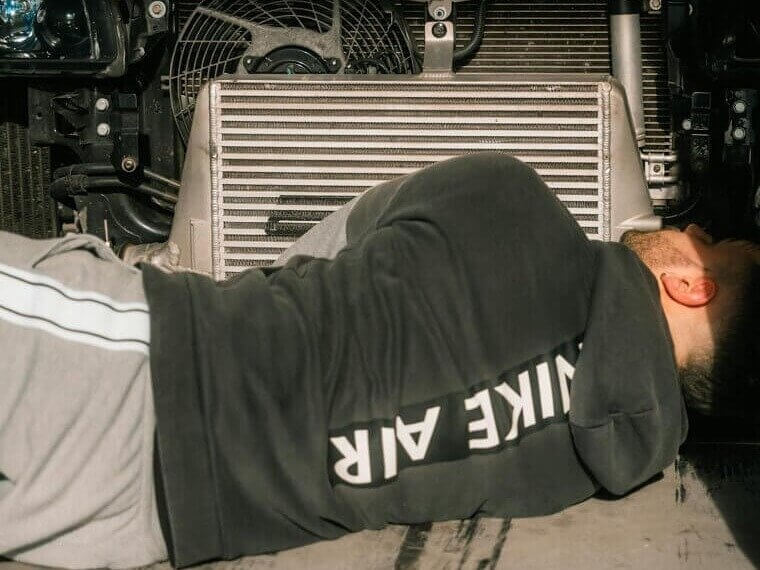Cracked Radiator
Weakened radiator housing may lead to bright green, orange, or pink puddles beneath the front of the car.
Worn or Damaged Oil Pan Gasket
The oil pan gasket keeps engine oil sealed inside the pan, but once the gasket weakens, oil begins to escape.
Loose or Broken Oil Filter
Oil filters need to be replaced regularly or oil can leak, which is typically amber-colored (but darkens with age).
Damaged Radiator Hose
Radiator hoses become brittle, causing leaks that often leave a sweet-smelling puddle. They should be repaired immediately.
Blown Head Gasket
This critical seal keeps oil and coolant apart. Leaking fluid causes white exhaust smoke, contaminated oil, or external coolant leaks.
Leaky Transmission Pan Gasket
A damaged gasket can leak transmission fluid, which is usually bright red and slippery, so it’s easy to spot and shouldn’t be overlooked!
Worn Axle Seals
When Axle seals wear out, fluid may seep near wheels or leave small puddles on the driveway. Requires immediate attention.
Faulty Power Steering Pump or Hoses
Pressurized fluid leaks often show up as reddish or amber puddles under your car, usually from faulty hoses or a failing pump.
Brake Line Leak
Usually clear to brownish with a slick feel, these leaks often appear near wheels or along brake lines. Even small leaks are dangerous.
Leaky Windshield Washer Reservoir or Hose
Washer fluid leaks are usually bright blue, green, or orange puddles under the car. They’re caused by cracked plastic reservoirs or split hoses.
Damaged Fuel Line or Injector Seals
Dangerous gasoline leaks are noticeable thanks to their strong smell. They may come from damaged fuel lines, corroded fittings, or worn injector seals.
Air Conditioning Condensation
Clear water pooling under the passenger side is often just harmless (and common) condensation from the air conditioning system.
Clogged Sunroof or AC Drain Tubes
When drain tubes get clogged, water may leak inside the cabin instead of outside. Cue damp carpets, water stains, or a musty smell.
Overfilled Fluids
These leaks usually appear after maintenance or DIY refills. Overfilling can cause pressure issues, so it’s best to correct matters promptly.
Corroded Coolant Overflow Tank
Coolant overflow tanks become brittle with age, allowing coolant to leak slowly, often leaving colorful residue near the reservoir.
Cracked Oil Pan
A cracked oil pan often results from hitting road debris or potholes, causing steady oil leaks and sometimes noticeable puddles underneath.
Damaged Valve Cover Gasket
When a valve cover gasket wears out, oil seeps onto the engine block, creating burning smells, smoke, and messy buildup over time.
Loose or Damaged Drain Plug
If the drain plug isn’t tightened correctly or its washer fails, oil slowly escapes, forming small puddles after routine oil changes.
Faulty Rear Main Seal
This tricky seal between the engine and transmission is a notorious source of leaks, often requiring major labor to replace properly.
Positive Crankcase Ventilation System Issues
A clogged PCV valve builds pressure inside the engine, forcing oil past gaskets and seals, leaving messy leaks around multiple areas.
Timing Cover Gasket Leak
The gasket sealing the timing cover can deteriorate, letting oil drip near the front of the engine and onto belts
Intake Manifold Gasket Leak
This gasket seals coolant and oil passages in the intake manifold. When it fails, leaks can cause engine misfires, overheating, or both!
Water Pump Leak
A failing water pump often leaks coolant from a weep hole, leaving bright green or orange drips beneath the engine.
Heater Core Leak
Coolant from a leaking heater core often collects inside the cabin, leaving damp carpets, sweet smells, and foggy interior windows.
Thermostat Housing Leak
The thermostat housing can crack or warp, allowing coolant to escape. Leaks here often leave visible residue around the housing itself.
Freeze Plug Corrosion
Freeze plugs in the engine block prevent cracking in cold weather. Over time, they corrode or rust, slowly leaking coolant outside.
Differential Fluid Leak
Leaking differential seals or gaskets cause gear oil to drip near the axles, often leaving strong smells and greasy residue beneath.
Transfer Case Leak
On 4WD or AWD vehicles, transfer cases can develop leaks from bad seals, reducing fluid levels and eventually causing driveline damage.
Clutch Slave Cylinder Leak
Manual transmissions rely on clutch hydraulics. If the slave cylinder leaks, fluid loss makes shifting harder and sometimes leaves puddles underneath.
Shock or Strut Leak
Shocks and struts are filled with hydraulic fluid. When seals fail, fluid seeps out, causing bouncy rides and poor handling.
Cracked Power Steering Reservoir
Plastic power steering reservoirs can crack with age or heat, causing fluid to leak near the pump and steering components.
Leaking AC Refrigerant
Unlike harmless condensation, refrigerant leaks leave oily residue on AC fittings or hoses, reducing cooling efficiency and sometimes triggering system failure.
Leaky Windshield Seal Allowing Water In
A worn or cracked windshield seal can let water seep inside during rainstorms, pooling on the dashboard or carpets unexpectedly.
Leaky Convertible Top Hydraulic System
Convertibles use hydraulic pumps and lines. When seals wear out, fluid leaks inside trunks or cabins, preventing smooth roof operation.
Windshield Washer Nozzle Leak
Cracked or disconnected washer nozzles can drip fluid even when unused, which are often mistaken for more serious leaks under the hood.



































